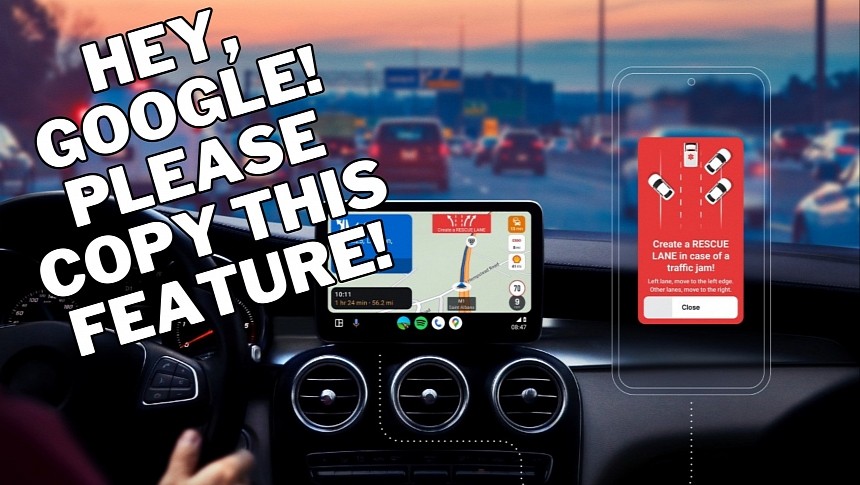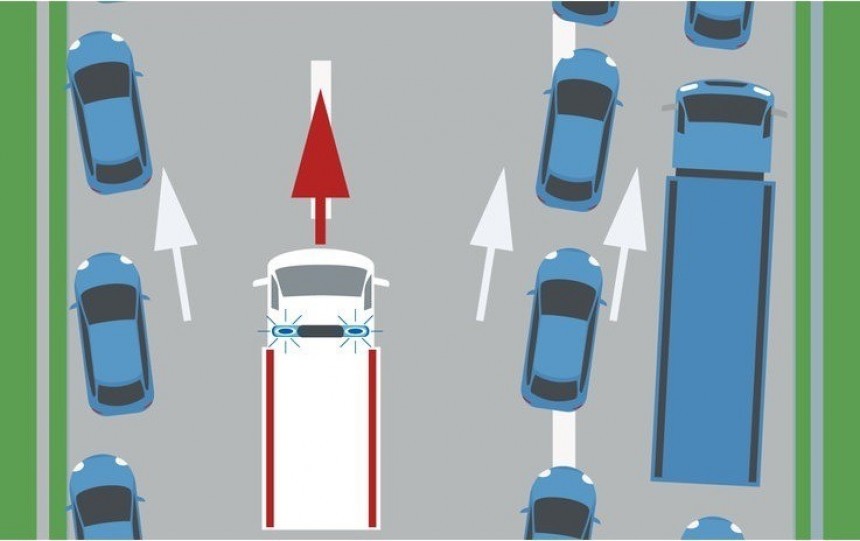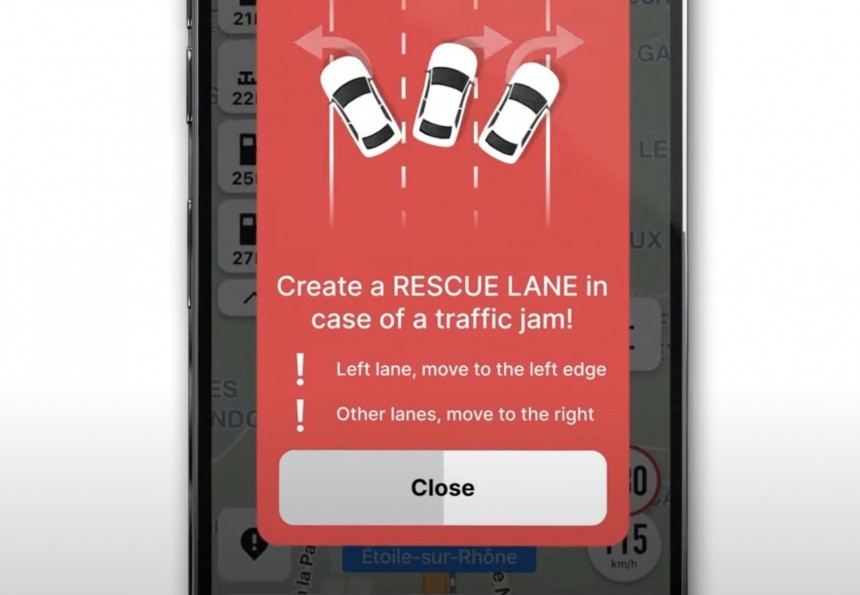A Google Maps competitor has recently launched a feature that could make a heck of a difference. Sygic is updating its software with warnings for the rescue alley lane, essentially telling drivers to clear the road when emergency vehicles might be in a rush to the scene of an accident.
Navigation apps are a great way to make the road more predictable, and Waze is probably the best example on this front.
Thanks to user reports, motorists are always up-to-date about what happens on their routes. Waze supports a wide variety of reports, including accidents, speed traps, potholes, broken traffic lights, heavy jams, and roadkill. As a result, getting traffic notifications on the screen helps the driver be prepared in advance, often giving them enough time to react accordingly.
Sygic has come up with another brilliant idea, this time not necessarily supposed to help drivers beat traffic jams but to clear the road for the first responders.
As everybody knows, every second counts when an emergency vehicle is rushing to help the victims of an accident. When traffic jams occur, ambulances spend critical time trying to go through, sometimes getting stuck until the rest of the vehicles in front start moving.
The emergency lane makes a huge difference on high-speed roads, such as highways, as the first responders can use it to get past traffic jams faster. If an emergency lane is not available, well, things are getting a lot more complicated, especially when a significant number of vehicles are caught in a traffic jam.
Several countries have come up with what's mostly known as the rescue alley rule. Some have already included it in traffic regulations, therefore making it an obligation for drivers, while others adopted it as a recommended practice (or drivers themselves use it because it makes so much sense when an accident takes place ahead).
The rescue alley rule comes down to a very simple concept: the vehicles on the road must clear the road to make room for emergency teams before they arrive at the scene. In the past, drivers tried to clear an entire lane, but the rescue alley rule simplifies things.
On a two-lane road, vehicles in the left lane must move as close as possible to the left shoulder, while vehicles in the right lane must move as close as possible to the right shoulder. Emergency vehicles would then have enough room to use the space between the two lanes.
On a multi-lane road, vehicles in the left lane must move close to the left shoulder, while all the other lanes must move to the right.
The application detects sudden stops and traffic jams on highways and high-speed roads and automatically suggests clearing the road for a rescue lane.
The notification shows up on the screen when navigation is active, but more importantly, it also provides instructions on how you must create the rescue lane. The on-screen instructions tell you where to go depending on the lane you use – Sygic's software can't tell what lane you're currently on, so the application displays straightforward instructions in the notification to help you move the vehicle in the correct direction.
On paper, this new alert sounds like a real life-saving feature, but it must prove it's working properly without offering any false warnings. Drivers tend to take everything their sat-nav says for granted, so a notification that tells them to create a rescue lane in case of a traffic jam could be rather inconvenient if no emergency vehicle approaches.
Eventually, the system should be improved using a connected car concept that would allow emergency vehicles to communicate with the other motorists and use an automated system to display such notifications on their screens. Obviously, it all sounds like science fiction right now, but the more vehicles evolved, the more such automated systems make sense, so don't be too surprised if this system eventually makes its way to next-generation cars.
In the meantime, Sygic's new feature is only available for users with the Premium+ license. The company says the notification shows up on the screen within seconds when traffic decelerates to a certain speed, essentially determining a sudden traffic jam ahead, possibly caused by an accident.
Applications like Waze should also adopt this concept, as a crowdsourcing engine could help the sat-nav determine an accident, its severity, and the likelihood of emergency vehicles approaching the scene. If all these apps work together and allow the exchange of data, all motorists would eventually know they must clear the road for a rescue lane, helping reduce the time needed for first responders to help the victims of an accident.
Thanks to user reports, motorists are always up-to-date about what happens on their routes. Waze supports a wide variety of reports, including accidents, speed traps, potholes, broken traffic lights, heavy jams, and roadkill. As a result, getting traffic notifications on the screen helps the driver be prepared in advance, often giving them enough time to react accordingly.
Sygic has come up with another brilliant idea, this time not necessarily supposed to help drivers beat traffic jams but to clear the road for the first responders.
As everybody knows, every second counts when an emergency vehicle is rushing to help the victims of an accident. When traffic jams occur, ambulances spend critical time trying to go through, sometimes getting stuck until the rest of the vehicles in front start moving.
The emergency lane makes a huge difference on high-speed roads, such as highways, as the first responders can use it to get past traffic jams faster. If an emergency lane is not available, well, things are getting a lot more complicated, especially when a significant number of vehicles are caught in a traffic jam.
Several countries have come up with what's mostly known as the rescue alley rule. Some have already included it in traffic regulations, therefore making it an obligation for drivers, while others adopted it as a recommended practice (or drivers themselves use it because it makes so much sense when an accident takes place ahead).
On a two-lane road, vehicles in the left lane must move as close as possible to the left shoulder, while vehicles in the right lane must move as close as possible to the right shoulder. Emergency vehicles would then have enough room to use the space between the two lanes.
On a multi-lane road, vehicles in the left lane must move close to the left shoulder, while all the other lanes must move to the right.
Sygic's new life-saving alert
Sygic has updated its navigation software with a notification to tell drivers when they must clear the road and create a rescue lane for emergency teams.The application detects sudden stops and traffic jams on highways and high-speed roads and automatically suggests clearing the road for a rescue lane.
The notification shows up on the screen when navigation is active, but more importantly, it also provides instructions on how you must create the rescue lane. The on-screen instructions tell you where to go depending on the lane you use – Sygic's software can't tell what lane you're currently on, so the application displays straightforward instructions in the notification to help you move the vehicle in the correct direction.
On paper, this new alert sounds like a real life-saving feature, but it must prove it's working properly without offering any false warnings. Drivers tend to take everything their sat-nav says for granted, so a notification that tells them to create a rescue lane in case of a traffic jam could be rather inconvenient if no emergency vehicle approaches.
In the meantime, Sygic's new feature is only available for users with the Premium+ license. The company says the notification shows up on the screen within seconds when traffic decelerates to a certain speed, essentially determining a sudden traffic jam ahead, possibly caused by an accident.
Applications like Waze should also adopt this concept, as a crowdsourcing engine could help the sat-nav determine an accident, its severity, and the likelihood of emergency vehicles approaching the scene. If all these apps work together and allow the exchange of data, all motorists would eventually know they must clear the road for a rescue lane, helping reduce the time needed for first responders to help the victims of an accident.











